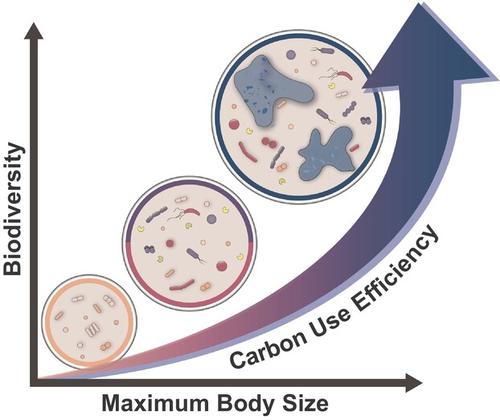当前位置:
X-MOL 学术
›
Environ. Microbiol.
›
论文详情
Our official English website, www.x-mol.net, welcomes your feedback! (Note: you will need to create a separate account there.)
The size and diversity of microbes determine carbon use efficiency in soil
Environmental Microbiology ( IF 5.1 ) Pub Date : 2024-05-11 , DOI: 10.1111/1462-2920.16633 Chansotheary Dang 1 , Ember M. Morrissey 1
Environmental Microbiology ( IF 5.1 ) Pub Date : 2024-05-11 , DOI: 10.1111/1462-2920.16633 Chansotheary Dang 1 , Ember M. Morrissey 1
Affiliation

|
Soil is home to a multitude of microorganisms from all three domains of life. These organisms and their interactions are crucial in driving the cycling of soil carbon. One key indicator of this process is Microbial Carbon Use Efficiency (CUE), which shows how microbes influence soil carbon storage through their biomass production. Although CUE varies among different microorganisms, there have been few studies that directly examine how biotic factors influence CUE. One such factor could be body size, which can impact microbial growth rates and interactions in soil, thereby influencing CUE. Despite this, evidence demonstrating a direct causal connection between microbial biodiversity and CUE is still scarce. To address these knowledge gaps, we conducted an experiment where we manipulated microbial body size and biodiversity through size‐selective filtering. Our findings show that manipulating the structure of the microbial community can reduce CUE by approximately 65%. When we restricted the maximum body size of the microbial community, we observed a reduction in bacterial diversity and functional potential, which in turn lowered the community's CUE. Interestingly, when we included large body size micro‐eukarya in the soil, it shifted the soil carbon cycling, increasing CUE by approximately 50% and the soil carbon to nitrogen ratio by about 25%. Our metrics of microbial diversity and community structure were able to explain 36%–50% of the variation in CUE. This highlights the importance of microbial traits, community structure and trophic interactions in mediating soil carbon cycling.
中文翻译:

微生物的大小和多样性决定土壤中的碳利用效率
土壤是来自所有三个生命领域的大量微生物的家园。这些生物体及其相互作用对于驱动土壤碳循环至关重要。这一过程的一个关键指标是微生物碳利用效率(CUE),它显示了微生物如何通过其生物质生产影响土壤碳储存。尽管不同微生物的 CUE 有所不同,但直接研究生物因素如何影响 CUE 的研究却很少。其中一个因素可能是身体大小,它会影响微生物的生长速度和土壤中的相互作用,从而影响 CUE。尽管如此,证明微生物多样性与 CUE 之间存在直接因果关系的证据仍然很少。为了解决这些知识差距,我们进行了一项实验,通过尺寸选择性过滤来操纵微生物的体尺寸和生物多样性。我们的研究结果表明,操纵微生物群落的结构可以将 CUE 降低约 65%。当我们限制微生物群落的最大体型时,我们观察到细菌多样性和功能潜力的减少,这反过来又降低了群落的 CUE。有趣的是,当我们在土壤中加入体型较大的微型真核生物时,它改变了土壤碳循环,使 CUE 增加了约 50%,土壤碳氮比增加了约 25%。我们的微生物多样性和群落结构指标能够解释 36%–50% 的 CUE 变化。这凸显了微生物特征、群落结构和营养相互作用在调节土壤碳循环中的重要性。
更新日期:2024-05-11
中文翻译:

微生物的大小和多样性决定土壤中的碳利用效率
土壤是来自所有三个生命领域的大量微生物的家园。这些生物体及其相互作用对于驱动土壤碳循环至关重要。这一过程的一个关键指标是微生物碳利用效率(CUE),它显示了微生物如何通过其生物质生产影响土壤碳储存。尽管不同微生物的 CUE 有所不同,但直接研究生物因素如何影响 CUE 的研究却很少。其中一个因素可能是身体大小,它会影响微生物的生长速度和土壤中的相互作用,从而影响 CUE。尽管如此,证明微生物多样性与 CUE 之间存在直接因果关系的证据仍然很少。为了解决这些知识差距,我们进行了一项实验,通过尺寸选择性过滤来操纵微生物的体尺寸和生物多样性。我们的研究结果表明,操纵微生物群落的结构可以将 CUE 降低约 65%。当我们限制微生物群落的最大体型时,我们观察到细菌多样性和功能潜力的减少,这反过来又降低了群落的 CUE。有趣的是,当我们在土壤中加入体型较大的微型真核生物时,它改变了土壤碳循环,使 CUE 增加了约 50%,土壤碳氮比增加了约 25%。我们的微生物多样性和群落结构指标能够解释 36%–50% 的 CUE 变化。这凸显了微生物特征、群落结构和营养相互作用在调节土壤碳循环中的重要性。































 京公网安备 11010802027423号
京公网安备 11010802027423号